Top Amazing Fun Facts About the Snow Leopard In 2023
Written by Sthitee Mohanty, senior writer
The snow leopard is the smallest big cat species. Know all about them here…
Written by Sthitee Mohanty, senior writer
Snow leopards are part of the big cat group (like lions, tigers, leopards, etc.) and live in the mountains of Asia. These are the only big cats that live in the cold deserts of Asia, exclusive to this single continent. They live in barren mountain areas.

They are very hard to spot and are sometimes referred to as the “ghost of the mountains”. They are solitary and nomadic
Did you know that the snow leopard, while not listed as endangered, is threatened because of many factors? It is listed as vulnerable on the International Union of Conservation of Nature’s (IUCN) Red List.
What’s the biggest threat to these big cats?
Humans!
Read on to know more about the elusive snow leopard!
They show fascinating adaptations to the rugged and cold land they call home.
Physical features of snow leopards

Like regular leopards, snow leopards also have spectacular coats – thick-furred and slate-grey/blue-grey. Their fur helps them camouflage to the rocky mountains and its denseness keeps them warm in the bitter cold.
Their long heavy tail helps them with balance while they climb steep surfaces. They are the biggest predators of these mountains and their prey mostly consists of mountain goats, birds, etc
Also, these cats are high-altitude acrobats. They have short forelimbs and long hindlimbs. These oddly shaped limbs help them travel the mountains better!
Did you know any of these fun facts about the snow leopard?
How many snow leopards are left?

No one knows for sure how many snow leopards exist now.
An estimate by researchers puts their total population at 3500-7000. The reason behind this uncertainty is that they are very difficult to spot. Solitary creatures, snow leopards avoid interacting with humans. It is hard to capture footage or any sort of information on these non-aggressive species.
Yet what’s worrying is that research shows that their numbers are dwindling (going down).
Human activity poses the biggest threat to the survival of snow leopards.
Poaching:
These cats are poached (hunted illegally) frequently – their hides (skin) and bones are sold at a high price. Mountain herders depend largely on their livestock for income. They kill any snow leopard that attacks their herd.
Moreover, hunters in mountains indirectly harm the snow leopards. They target the prey of these big cats, disturbing the mountain ecosystem. With a decrease in prey population, it becomes harder for the snow leopard to hunt and feed itself.
Read on for more information about this majestic animal, and where snow leopards are found in India.
Top 20 Fun Facts About the snow leopard In 2022
Here are some fun facts about the snow leopard:
1. The snow leopard is the smallest big cat species.

Their small size makes it easier for them to survive on these mountains. The smaller the body size, the easier it is for an animal to regulate their body heat. The small body size means that they spend less energy on heat regulation. Since prey is scarce in the mountains, this is a very useful adaptation.
2. Snow leopards have snowshoe paws!

Their paws are wide and fur covered, keeping them from sinking into the thick layers of mountain snow.
3. The snow leopard’s long fluffy tail acts as its scarf!

At night, their tail keeps them warm while hiding them too. Their tails can grow up to 36 inches or 3 feet!
4. Their noses are wide and big
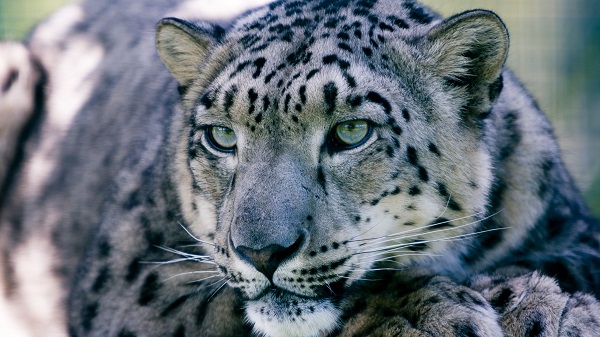
This is to warm the air they breathe in (since they live in freezing places)
5. They can jump up to 50 feet.
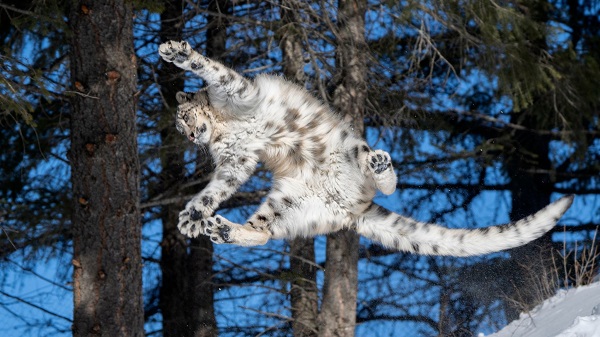
This helps them while hunting in the mountain range.
6. A snow leopard cannot roar

Their main call is a ‘piercing’ yowl. They can even mew, puff, and growl.
7. The main prey of the snow leopard is the bharal or the blue sheep

In Nepal, one of the few countries where snow leopards are found, the snow leopard hunts the bharal or the blue sheep (which are neither blue nor sheep). They are more closely related to goats.
They also hunt ibex and argali – both of which are wild sheep
8. The snow leopard is not actually a leopard

Genetically, they are more closely related to tigers than leopards.
9. A snow leopard can run a marathon

It can travel almost 40 kilometers in one night.
10. Snow leopards migrate
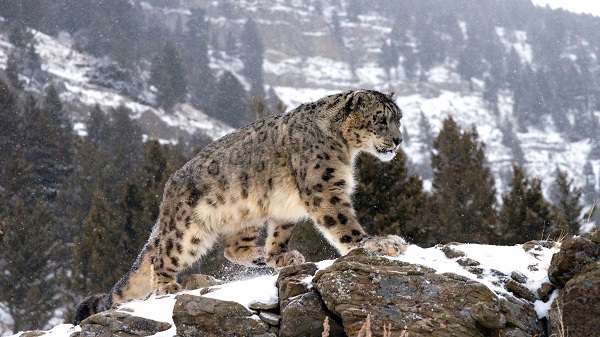
They move from one height to another with seasonal change. They move upwards in the summer and far down in the winter to avoid the bitter cold.
11. Snow leopards are crepuscular animals
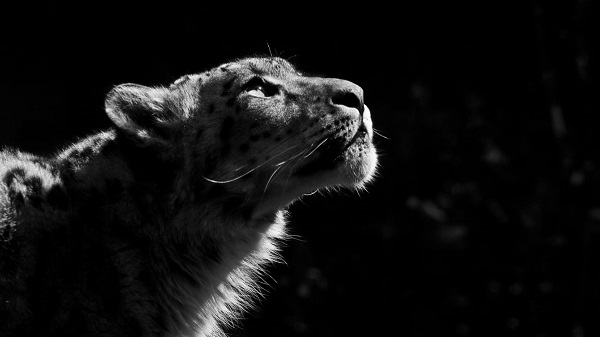
Crepuscular animals are those that are active at twilight – when the sun is going down. Though snow leopards are also active at dawn. They’re early risers and early sleepers!
12. Snow leopards are opportunistic hunters
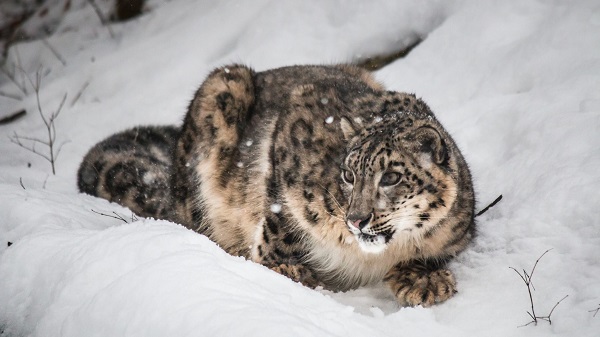
They are the only big cat species to behave so. They aren’t picky eaters! They hunt whatever prey they can get.
13. A snow leopard knows when to back away
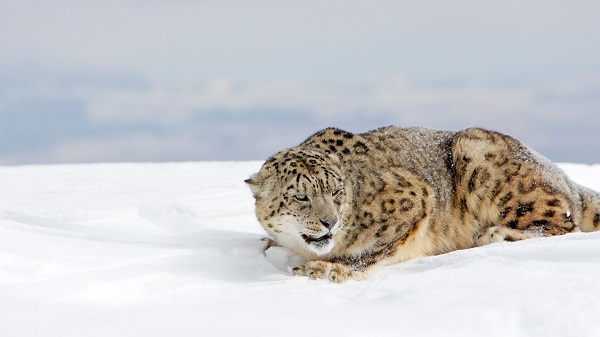
It’s not aggressive over its kills. If challenged for it, they let go of the meal. Howevver, snow leopards are so powerful that they can kill prey up to three times their own weight.
14. Many names for the big cat
Locals who live in the same mountaneous regions as the snow leopards have many names for the it: “wāwrīn pṛāng” in Pashto, “shan” in Ladakhi, “zigsa” in Tibetan, “irves” in Mongolian, and “barfānī chītā” or “him tendua” in Hindi.
15. Many organizations work hard to conserve the snow leopard
These are: The Snow Leopard Project, Snow Leopard Trust, Snow Leopard Conservancy, Global Snow Leopard and Ecosystem Protection Program, WWF, and TRAFFIC.
WWF reported that snow leopards live at an altitude of 5859 meters above sea level – the highest altitude ever recorded for a big cat!
16.Snow leopards are mysterious for the locals

Local folklore calls them “ghosts of the mountains” and “shape-changing mountain spirits”.
17. Female snow leopards are single moms

They raise their cubs all alone for about 18 months.
18. Snow leopards are not usually aggressive toward humans
19. They can live up to 13 years

If they are in the wild, snow leopards can live to anywhere from 10 to 13 years. In captivity, they can go to 22 years.
Where are snow leopards found?
Snow Leopards are found only in the steep, rocky mountains of Central Asia (including the Himalayas).
They live in very harsh land – it is primarily arid and barren, without any trees and sparse vegetation. They have to climb great heights and steep slopes.
Did you know that the snow leopard is also called the Grey Ghost?
Where are snow leopards found in India?
If you want to know more about where are snow leopards found in India, the read on…
They inhabit the crowning mountain range of the country, the Himalayas!
In India, snow leopards are found in the western Himalayan states of:
Uttarakhand
Himachal Pradesh
Ladakh
Sikkim
Arunachal Pradesh.
Researchers estimate that 450-500 snow leopards live in India.
Snow leopards can be found in the following National Parks of India: Hemis National Park in Ladakh, Great Himalayan National Park in Himachal Pradesh, Nanda Devi National Park in Uttarakhand, Khangchendzonga National Park in Sikkim, and Namdapha National Park in Andhra Pradesh.
Here’s another fun fact about snow leopards you may not know: Himachal Pradesh has the snow leopard as its official state animal!
The Indian Wildlife (Protection) Act, 1972, lists the snow leopard under Schedule 1, giving it the highest legal protection status.
So, a summary of where snow leopards are found, here’s a quick look:
| Snow Leopards live in twelve Central Asian countries: |
| Afghanistan |
| Bhutan |
| China |
| India |
| Kazakhstan |
| Kyrgyzstan |
| Mongolia |
| Nepal |
| Pakistan |
| Russia |
| Tajikistan |
| Uzbekistan |
Their range spans about two million square miles, which is about half the size of Greenland.
Of the estimated population, 50% of them live in China.
Types of the snow leopards in India
There aren’t types of snow leopards per se. There are subspecies, of course!
There are three subspecies of the snow leopard:
Panthera uncia uncia, Panthera uncia uncioides, and Panthera uncia irbis.
They are subdivided into these subspecies based on geography, one of the primary differentiating factors.
Before sufficient research was done, the snow leopard was believed to be monotypic – the species had no subspecies. Yet, studying the entire habitat range of the snow leopard has revealed the existence of their subspecies.
A whole population genetic survey (the genes of every individual are sampled and collected to understand the genetic condition of the population as a whole) revealed three primary “genetic clusters” of the big cats. Each genetic cluster qualifies as its subspecies.
The research was conducted by a research team led by Dr. Jan E. Janecka, a biology professor at Duquesne University in Pittsburgh, PA. DNA collected from the scat samples from frequented wildlife trails, revealed more about the snow leopard.
The first genetic cluster is a Northern subspecies in the Altai region.
The second is a Central subspecies in the core Himalayas and Tibetan Plateau regions.
The third is the Western subspecies in the Pamir, Tian Shan, and trans-Himalaya mountain ranges.
Thus, habitat and geography are the primary differences between these subspecies. Panthera uncia irbis is the Northern group, Panthera uncia uncia is the Western group, and Panthera uncia uncioides is the Central group.
Something called the desert basin barrier effect comes into play, dividing the Northern subspecies from the Western and Central subspecies. Geography acts as a physical barrier, isolating one group of snow leopards from the other two groups. The snow leopards cannot breed with the other groups, reducing genetic diversity (diverse groups with diverse genes lead to greater genetic diversity).
What are subspecies?
In a taxonomic system (biology has these systems that make identifying species easier – they are known as taxonomic systems), a subspecies is ranked below species.
A species can be further classified into subspecies.
Mostly the difference between subspecies arises from geographical barriers.
Subspecies classification has the following benefits:
- The evolution and ecology of the species are understood better.
- Conservation policies become more nuanced and adapted to each subspecies in each particular area.
Other big cat subspecies
Not just snow leopards but lions, tigers, and leopards have subspecies as well.
| Big Cat | Subspecies |
|---|---|
| Lion | The Asiatic lion and the African lion. |
| Leopards | African, American, Indian, Indo-Chinese, Sri Lankan, Amur, and Javan. |
| Tigers | Continental and Sunda tigers |
Before ending, what’s important to know is that a lot more needs to be done to form better conservation policies for snow leopards. Their population is doing down mainly because of habitat loss and fragmentation, climate change, and human activity – mainly illegal wildlife trade.
Hope you liked this article – let us know if you find more fun facts about the snow leopard. Tell us what can be done to conserve this beautiful animal!

Better Your Child’s G.K. In 3 Minutes – Get This Free Newsletter
Get fun facts, simple and easy news, quizzes, and lots of other interesting things to read in your mailbox – for free! It’s what we call GK-on-the-go!
I Kid You Not now has a large readership across India and also parts of the world. If you want to write for us, you can submit your story here. You can also apply to become a news anchor. Apply here



Comments